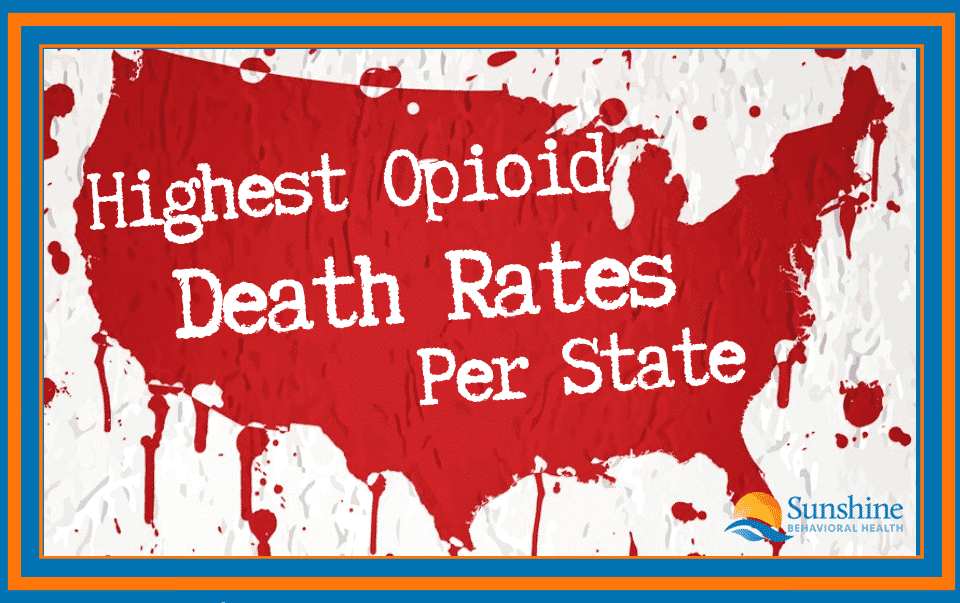
Drug overdoses caused 70,237 U.S. deaths in 2017, according to the Centers for Disease Control and Prevention (CDC) reported. Opioid overdoses caused 47,600 (68 percent) of those deaths. Clearly, opioids are a major factor in overdose deaths in the country.
Since 2013, almost every U.S. state has reported increased rates of drug overdose deaths. The only states who have not reported such increases are Oklahoma, Mississippi, and Kansas. Some states experienced significantly higher rates of opioid overdose-related deaths than others.
States who have reported statistically significant increases in overdose deaths also have high rates of overdose deaths. Here are five states with high opioid overdose deaths in the United States.
West Virginia
According to the National Institute of Drug Abuse (NIDA), the state of West Virginia reported a drug overdose death rate of 43.4 people per every 100,000 people in 2016. This was the highest rate for any state in the U.S. that year. In 1999, by comparison, the rate was much lower: 1.8 deaths for every 100,000 people.
Of the 733 reported deaths from opioid overdose in West Virginia in 2016, synthetic opioids were responsible for 435 deaths. Of that number, prescription opioid overdoses contributed to 340 deaths.
New Hampshire
With 35.8 deaths per 100,000 people, New Hampshire experienced the second highest overdose death rate in the United States in 2016. New Hampshire had about triple the national average death rate since the U.S. overdose death rate in 2016 was 13.3 deaths per 100,000.
New Hampshire recorded 437 deaths related to opioid overdoses in 2016. Synthetic opioids contributed to 363 deaths, prescription opioids caused 89 deaths, while heron killed an additional 34 people.
Ohio
Coming in third place for the number of overdose fatalities in 2016 was the state of Ohio. The drug overdose fatality rate in 2016 was 32.9 deaths in every 100,000 Ohio residents. The state also had one of the highest numbers of opioid overdose deaths in 2016: 3,613 deaths.
As in other states, synthetic opioids contributed the largest share of opioid deaths in Ohio. In 2016, synthetic opioids were implicated in 2,296 overdose-related deaths. Heroin overdoses claimed 1,478 lives in 2016, while overdoses related to prescription opioids resulted in 867 deaths that same year.
Maryland
Maryland’s death rates due to opioid overdose have remained consistently above the national average since the beginning of the century. In 2016, Maryland’s rate was 30 deaths per 100,000 people.
Fentanyl accounted for most of the overdose-related deaths in Maryland in 2016. As in other U.S. states in 2016, synthetic opioids contributed the largest amount of overdose deaths in Maryland. Synthetic opioids accounted for 1,091 deaths, prescription opioids caused 812 deaths, and heroin contributed to 650 deaths.
District of Columbia
Washington, D.C. counted among the areas with the highest 2016 opioid fatality rates in the country. In 2016, the state had the fifth-highest rate of deaths related to opioids: 30 deaths per 100,000 people. The National Institute on Drug Abuse (NIDA) reported 209 deaths associated with overdoses in Washington, D.C. in 2016. Of this number, synthetic opioids were implicated in 129 deaths and overdoses on prescription opioids caused 66 deaths.
States with the highest death rates also experienced significant increases in yearly death rates. These statistics illustrate how opioid abuse can be more than dangerous. It can be deadly. Questions or concerns? Are you dealing with opioid issues of your own? If so, reach out to Sunshine Behavioral Health today.A Message From Our CEO
Medical disclaimer:
Sunshine Behavioral Health strives to help people who are facing substance abuse, addiction, mental health disorders, or a combination of these conditions. It does this by providing compassionate care and evidence-based content that addresses health, treatment, and recovery.
Licensed medical professionals review material we publish on our site. The material is not a substitute for qualified medical diagnoses, treatment, or advice. It should not be used to replace the suggestions of your personal physician or other health care professionals.





